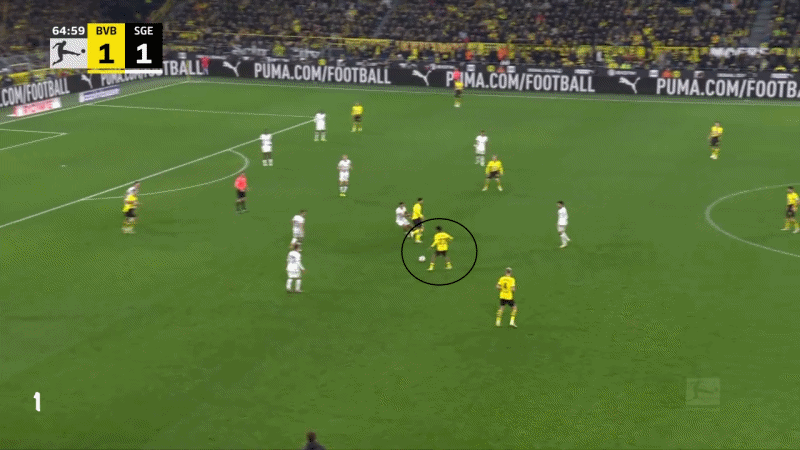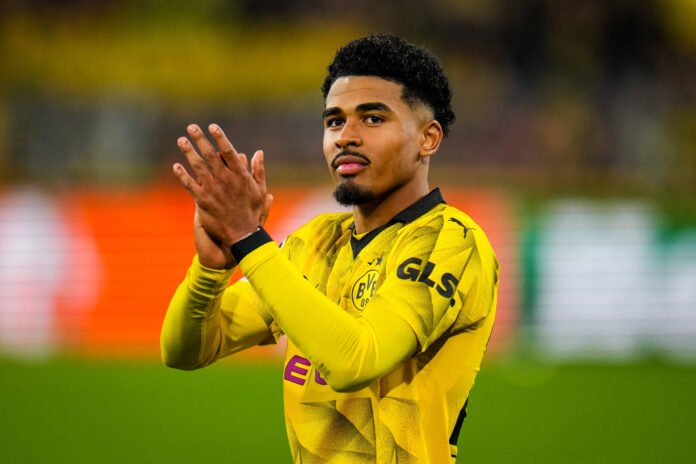Ian Maatsen produced one of the moments of Borussia Dortmund’s season. It set the Westfalenstadion ablaze on a wild Champions League night against Atletico Madrid.
Cutting into the penalty box from the left, Maatsen collected Marcel Sabitzer’s backheel, drove infield, then slashed a shot across Jan Oblak and in off the far post.
His goal gave Dortmund the lead for the first time in a tie that they would ultimately win. But it characterised his effect since arriving on loan from Chelsea. He has played with purpose and precision, and often with intricacy too. Maatsen has provided something that Dortmund had been lacking.
It made him quickly popular.
Maatsen is the Chelsea loanee who has helped propel his new club into a Champions League semi-final against Paris Saint-Germain. He arrived from England on January 12 and, within two weeks, the German media were smitten. After wins against Darmstadt and Cologne, Bild wondered aloud whether the loan could be made permanent. A few days later, Kicker, the country’s biggest football magazine, celebrated the “new ideas” Dortmund suddenly had, attributing the rising quality of possession to Maatsen’s arrival.
“He always wants the ball and he’s really clever in how he uses it and how he positions himself — he always finds the right pass,” said goalkeeper Gregor Kobel after the Cologne game.
“Ian was very important to us,” added Sebastian Kehl, the club’s sporting director.
Maatsen arrived in January and has swiftly become integral at Dortmund (Alex Gottschalk/DeFodi Images via Getty Images)
He has remained important. While Maatsen’s performances have fluctuated, he has been a partial solution to a problem that has stalked Dortmund throughout the season, perhaps for longer: they do not create enough chances.
That is still true now. The 41 goals they have scored from open play in the Bundesliga makes them only the fifth-highest scorers in the division, commensurate with their league position, but more comparable to Eintracht Frankfurt (41) and Hoffenheim (40), than RB Leipzig (54), Stuttgart (59), Bayern Munich (67) and Bayer Leverkusen (55).
Dortmund are also slightly overperforming their expected goals (xG), which helps to illustrate the issue. Their chance creation from open play is insufficient. One of the more concerning data trends this season is that, among the top 40 players ranked by number of chances created, there are just two from Dortmund: Julian Brandt and Niclas Fullkrug.
Get the latest transfer news on The Athletic…
Perhaps that describes a decline in individual talent; the loss of Jude Bellingham would be hard for any team to overcome.
A better observation might be that Dortmund’s football coming out of their own defensive zone and through midfield has lacked quality and speed, in turn heightening a dependence on playmaking quality that is in short supply.
Dortmund have already started to address this issue. Sven Bender and Nuri Sahin rejoined the club as assistant coaches in December 2023, Bender to work on the defensive side of the game and Sahin with the attack. When the appointments were announced, head coach Edin Terzic hailed Sahin’s “great feel for offensive processes and spaces”, which described precisely what the team was searching for.
Those who attended their January training camp in Marbella noticed how involved Sahin was and how much emphasis was placed on advancing the ball up the pitch.
Maatsen would not join the club until the squad returned to Germany, but his signing, too, was a response to the issue. Dortmund needed more originality in the build-up. But they needed a player who better suited that aim than their existing left-back options: Ramy Bensebaini, who has been a disappointment since arriving from Borussia Monchengladbach in the summer of 2023, and Julian Ryerson, who is more natural on the right.

Maatsen ahead of Dortmund’s game against Bayer Leverkusen at Signal Iduna Park (Alexandre Simoes/Borussia Dortmund via Getty Images)
The logic behind Maatsen’s recruitment is easy to follow.
He is certainly nimble and skilful enough to play the traditional attacking role of a full-back, by overlapping, accelerating and producing cut-backs and crosses from the goal line, but his technical profile allows him more involvement.
According to fbref.com, he averages 5.9 progressive passes per 90 minutes (94th percentile), 41.8 touches in the middle third of the pitch per 90 (94th) and ranks in the 96th percentile for total carrying distance per game (285.4 yards).
Practically, that has several implications — and combined, they explain why the response to Maatsen has been so positive.
As Kobel suggested in January, he is comfortable receiving possession anywhere: directly from the goalkeeper, from the centre-backs, on the touchline or infield. Secondly, when he does have the ball, he tends to be aggressive in how he carries or distributes it. That can be at the base of midfield, alongside a deep midfielder, or with a winger ahead of him — usually Jadon Sancho, the other loanee who joined in January.
The best example of those qualities working in tandem might come from Dortmund’s 3-1 win against Frankfurt at the Westfalenstadion in March.
The sequence below shows Maatsen high up the field in the central third of the pitch and surrounded by visiting defenders. From that position, really operating as a second No 6, he wedged a pass up and over the defensive line, perfectly into the stride of Jamie Bynoe-Gittens…

Bynoe-Gittens took a bad touch and the chance was lost, but it was still a fine example of how Maatsen has been able to alleviate some of Dortmund’s issues and, more generally, how valuable full-backs who can invert are in the modern game.
Maatsen is a functioning component within Terzic’s side. He has had bad games among the good and there is no need to embellish his impact. But, while there are grumbles concerning other parts of the team, his area is working: he is the right sort of player, playing in the right way.
If he were to stay beyond the summer, it would certainly be interesting to see how he might develop in Dortmund.
But that future is uncertain. Dortmund are a club in transition in every sense. Hans-Joachim Watzke, the CEO, will step down in the summer of 2025. The sporting side of his role has already been inherited by Lars Ricken, previously head of the academy. On the pitch, several players, including Donyell Malen, are expected to leave at season’s end and a permanent move for Sancho would be financially challenging.
Will Maatsen be a priority? It’s difficult to know, but with a £35million ($43.9m) release clause and Chelsea seeking to comply with the Premier League’s profit and sustainability rules (PSR), it’s clear that he should be.
(Top photo: Rene Nijhuis/MB Media/Getty Images)
Read the full article here


